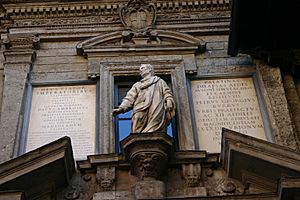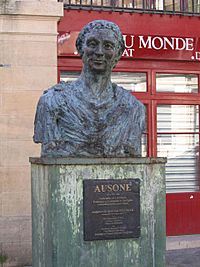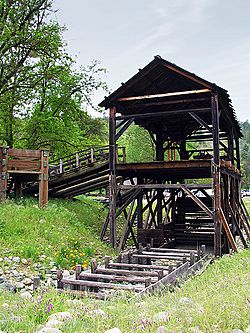Ausonius facts for kids
Quick facts for kids
Decimius Magnus Ausonius
|
|
|---|---|

Monument to Ausonius in Milan.
|
|
| Born | c. 310 |
| Died | c. 395 |
| Nationality | Roman |
| Occupation | poet, teacher |
| Relatives |
|
Decimius Magnus Ausonius (born around 310 AD – died around 395 AD) was a famous Roman poet and teacher. He taught rhetoric, which is the art of speaking and writing well. Ausonius came from Burdigala, a city in what is now France.
For a time, he was the private tutor to Gratian, who later became a Roman Emperor. Gratian liked Ausonius so much that he made him a Roman consul. This was one of the highest jobs in ancient Rome.
Ausonius's most well-known poems are Mosella and Ephemeris. Mosella describes the Moselle River. Ephemeris tells about a typical day in his life. His other poems show how much he cared for his family, friends, and teachers. He also enjoyed playing with different poetry styles.
Contents
Ausonius's Life Story
Decimius Magnus Ausonius was born around 310 AD in Bordeaux. His father, Julius Ausonius, was a doctor with Greek family roots. His mother, Aemilia Aeonia, came from a rich family in Gaul (ancient France).
Ausonius had a strict upbringing from his aunt and grandmother. He got a great education in Bordeaux and Toulouse. His uncle, Aemilius Magnus Arborius, was a professor there. Ausonius was very good at grammar and rhetoric. But he said he struggled a bit with Greek.
In 328 AD, his uncle was called to Constantinople. He became a tutor to Constans, a son of Emperor Constantine the Great. Ausonius then went back to Bordeaux. He finished his studies with a teacher named Minervius Alcimus.
Becoming a Teacher
After finishing school, Ausonius first trained to be a lawyer. But he liked teaching more. In 334 AD, he became a grammaticus, which means an instructor, at a school in Bordeaux. Later, he became a rhetor, or professor.
Many students came to learn from him. Some of them became important people in public life. His most famous student was Paulinus. Paulinus later became a Christian and a bishop.
Working for the Emperor
After teaching for thirty years, Emperor Valentinian I asked Ausonius to teach his son, Gratian. Gratian was going to be the next emperor. Ausonius went with Valentinian and Gratian on their military trips in 368–369 AD.
Ausonius used his writing skills to help his career. Emperor Valentinian gave him the rank of quaestor. This was an important financial job in the Roman government. Being at the emperor's court helped Ausonius meet many powerful people. In 369 AD, he met Quintus Aurelius Symmachus, and they became good friends.
Gratian liked and respected his old teacher. When Gratian became emperor in 375 AD, he gave Ausonius and his family high honors. That year, Ausonius became the Praetorian Prefect of Gaul. This was a very powerful job, like being a chief minister. He even got a slave girl named Bissula as a prize from a war. Ausonius wrote a poem to her. His father, who was almost 90, also got a high rank.
In 376 AD, Ausonius's son, Hesperius, became the proconsul of Africa. This was like being a governor. In 379 AD, Ausonius received the highest Roman honor: he was made a consul.
Retirement
In 383 AD, a general named Magnus Maximus rebelled against Emperor Gratian. Gratian was killed. When the new emperor, Valentinian II, was forced out of Italy, Ausonius decided to retire. He went back to his family lands near Bordeaux.
When Magnus Maximus was defeated in 388 AD, Ausonius stayed on his country estates. He called them his "nest of old age." He spent the rest of his life there, writing poetry and letters to his friends. Many of these friends had been his students. Some people believe that the famous Château Ausone vineyard is on land that once belonged to him.
Ausonius became a Christian later in his life. He died around 395 AD. His grandson, Paulinus of Pella, also became a poet.
Ausonius's Writings
Ausonius wrote many different kinds of poems and texts. Here are some of his most famous works:
- Epigrammata: About 120 short poems on various topics.
- Ephemeris: Describes his daily activities from morning to night.
- Parentalia: 30 poems about his family members who had passed away.
- Commemoratio professorum Burdigalensium or Professores: A list of famous teachers from his hometown of Bordeaux.
- Caesares: Poems about the 12 Roman emperors described by the writer Suetonius.
- Ordo urbium nobilium: Poems about 17 important Roman towns, from Rome to Bordeaux.
- The Idyllia: This group of 20 pieces includes his most famous poem, the Mosella.
- Cento nuptialis: A poem made by taking lines from the famous Roman poet Vergil.
- Epistolarum liber: 25 letters written in poetry form.
- Ad Gratianum gratiarum actio pro consulatu: A speech in prose thanking Emperor Gratian for making him a consul.

What People Thought of His Works
People during Ausonius's time admired his writings. But later, his works were not seen as the best examples of Latin literature. His writing style was easy to read. His poem Mosella is still liked for its descriptions of life along the Moselle River. However, some people thought his work was not very original.
The famous historian Edward Gibbon once wrote that Ausonius's fame "condemns the taste of his age." This means that Gibbon thought people in Ausonius's time didn't have very good taste in poetry if they liked Ausonius so much.
The Roman Sawmill
Ausonius's writings are also interesting because they mention a special machine. He wrote about a water mill that sawed marble on a river that flowed into the Moselle.
He wrote:
....renowned is Celbis for glorious fish, and that other, as he turns his mill-stones in furious revolutions and drives the shrieking saws through smooth blocks of marble, hears from either bank a ceaseless din...

This small detail from his poem tells us new things about Roman technology. It shows that Romans used water power for different tasks. It is one of the few times Roman writers mention water mills used to cut stone. This also suggests they might have used them to cut wood.
Earlier Roman writers like Vitruvius (around 25 BC) and Pliny the Elder (77 AD) also wrote about water mills. These mills became even more common after the Roman Empire fell.
The mills at Barbegal in southern France are famous. They used water power to grind grain into flour. They were built in the 1st century AD. There were 16 mills working together on a hill near Arles.
Building a sawmill can be simpler than a flour mill. Sometimes, the saw blade can be turned directly by the water wheel. The Sutter's Mill in California is an example of this. However, the sawmill at Hieropolis in Asia Minor used a different system. It had a frame saw that moved up and down using a crank and a connecting rod.

See Also
 In Spanish: Ausonio para niños
In Spanish: Ausonio para niños

